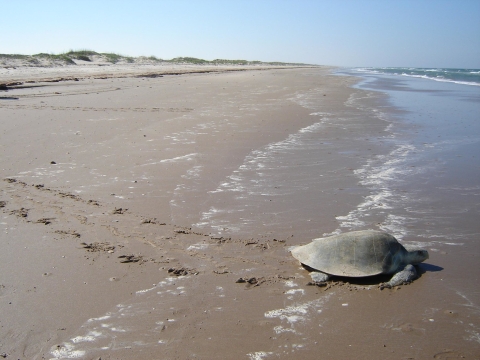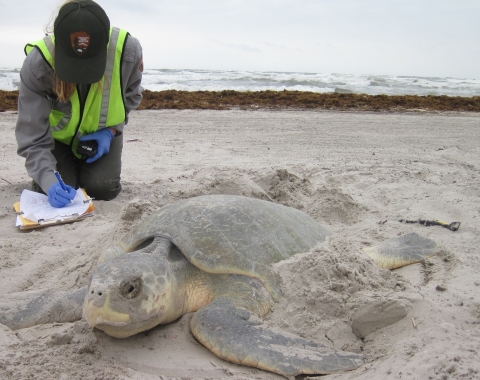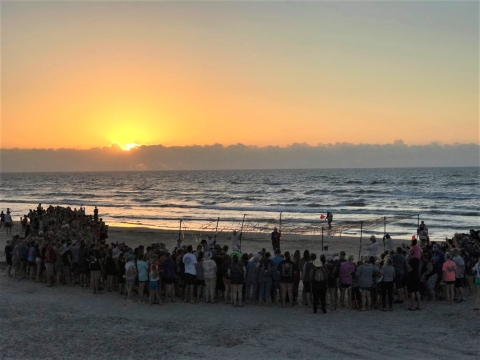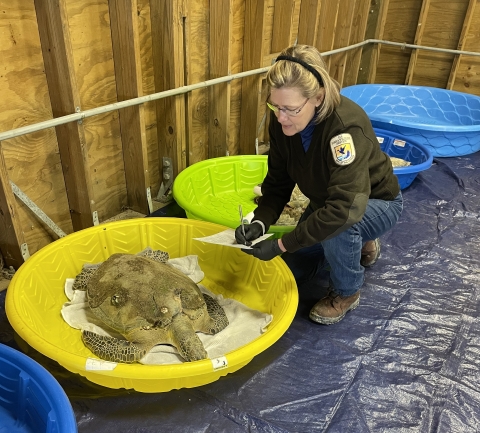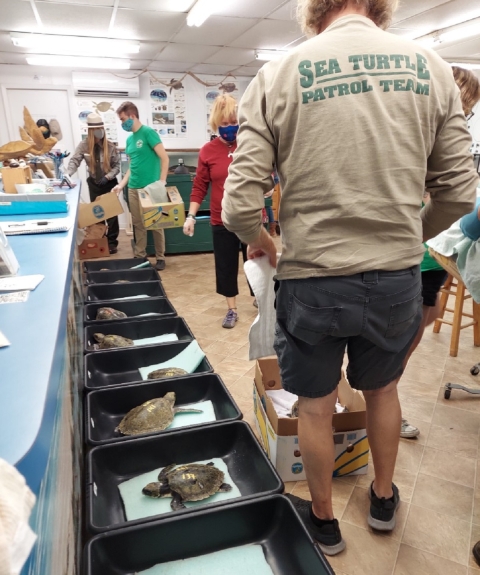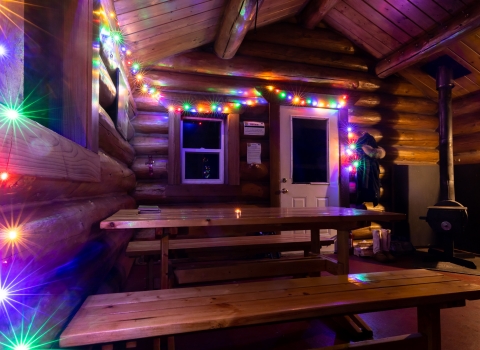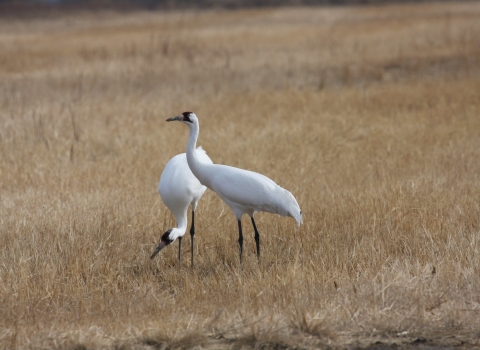When the U.S. listed the Kemp’s ridley sea turtle as endangered in 1970, the species was on the brink of extinction. Decades of intensive egg collection, killing of nesting females, and bycatch and drowning in the commercial and recreational fisheries of the U.S. and Mexico had resulted in the once thriving species being nearly wiped out throughout its range.
How much did they decline? In 1947, a researcher counted more than 40,000 nesting Kemp’s ridley sea turtles at their primary nesting site in Rancho Nuevo, Tamaulipas, in northeast Mexico in a single day. In the following decades, this “arribada” would be reduced to under a thousand nests found during entire seasons.
This dramatic loss prompted local recovery efforts for the species in Mexico in the 1960’s, but the Kemp’s ridley population continued to suffer. Under the authority of the Endangered Species Act of 1973, which provides a framework to conserve and protect endangered and threatened species and their habitats both domestically and abroad, the U.S. Fish and Wildlife Service was able to join the effort to save the struggling sea turtle in the late 1970’s.
In 1978, the Service and partner agencies launched an ambitious plan to save the species from extinction. The project focused on protecting nesting turtles, eggs, and hatchlings in the U.S. and Mexico and establishing a second nesting colony of Kemp’s ridley sea turtles at Padre Island National Seashore, and later implementing and enforcing regulations requiring the use of turtle excluder devices on commercial shrimping trawlers.
“Saving the Kemp’s ridley sea turtle is one of the greatest ESA success stories of our time,” said Mary Kay Skoruppa, the Service’s Sea Turtle Coordinator for Texas. “While continued efforts are needed to fully recover the species, actions undertaken for the species in the last 50 years are paying off and we are seeing increased numbers of Kemp’s ridley sea turtles nesting in the U.S. and Mexico.”
Secondary Nesting Colony
Because the majority of Kemp’s ridley sea turtles nest in the western Gulf of Mexico, one natural disaster in the Rancho Nuevo area could severely impact the species. One of the first goals of the binational program was to form a secondary nesting colony at Padre Island National Seashore in South Texas. This site was chosen due to its long-term federal protection, undeveloped beaches, and because it is within the native nesting range of the species.
From 1978-1988, eggs from a portion of the Kemp's ridley nests laid each year at Rancho Nuevo were collected and shipped to Padre Island National Seashore. After incubation the hatchlings were released with the hope that they would imprint on the beach and return to the same area to nest as adults. After allowing the hatchlings to embark on a short swim, researchers recaptured them and raised them in a lab in Galveston, Texas until they were big enough to be tagged for identification and avoid predators.
In the years following the release of these young turtles, National Park Service (NPS) Division of Sea Turtle Science and Recovery staff searched the beaches every year during the nesting season for any signs that they were returning. Finally, beach patrollers found the first tagged Kemp's ridley returned to nest on Padre Island in 1996.
Since that year, when only six Kemp's ridley nests were found in Texas, the number of nesting sea turtles has increased significantly. In 2017, staff documented 353 nests, the largest number ever recorded in Texas. With surges in nesting numbers generally occurring every three years, Skoruppa is hopeful 2023 will be a record-breaking year.
“The vast majority of Kemp’s ridley sea turtles nest in Mexico, but having a secondary nesting location in the U.S. is important to provide redundancy and help safeguard the species from a catastrophic event in Mexico,” Skoruppa said. “Today, more Kemp’s ridley sea turtle nests are found at Padre Island National Seashore than any other location in the U.S. We are grateful for the National Park Service’s long-term partnership in conserving and working to recover this iconic species.”
Turtle Excluder Devices
Though the partners immediately began implementing conservation actions for the species in the late 1970’s, the population did not immediately bounce back. In fact, only 702 nests were recorded in Rancho Nuevo in 1985 - a 99.4% decline.
This began to reverse in the early 1990’s, thanks in part to a new regulatory requirement implemented under the authority of the ESA. In 1989, shrimping boats and other commercial fisheries were required to begin using turtle excluder devices to reduce bycatch of sea turtles.
These devices are made of metal bars and mesh that fit inside the neck of a trawl net. While shrimp pass between the bars to the back of the net, turtles and other larger animals bump against the metal grid and escape through a flap in the mesh.
While mortality from commercial and recreational fisheries remains a threat, the use of turtle excluder devices by commercial shrimpers has been a game changer in the conservation and recovery of Kemp’s ridley and other sea turtle species in the Gulf of Mexico.
Protecting Nests
In addition to reducing threats in the water, nest protection in the U.S. and Mexico is essential in recovering the Kemp’s ridley. Without protection, nests are vulnerable to being crushed by vehicles, predation and inundation by tides.
In Texas, organized patrols to find and protect Kemp's ridley and other sea turtle nests are conducted across hundreds of miles of Texas beaches every year. In Mexico, nest detection and protection programs are also conducted throughout much of the Kemp’s ridley nesting range.
Once a nest is located in Texas, staff move the eggs to protected areas and monitor them to help increase the survival of the hatchlings. Upon hatching, the baby sea turtles are immediately released onto the beach and into the Gulf of Mexico.
At Padre Island National Seashore, the public is invited to watch some of these hatchling releases when they are compatible with the needs of the turtles. According to the Padre Island National Seashore website, this is the most popular interpretive program held at the park, with hundreds to more than 1,000 people attending each of the public releases every year.
“One of the things that’s very rewarding to me and to everybody that works hard in the nest protection program and recovering Kemp’s ridley sea turtles is seeing the public’s reaction and the public support,” Skoruppa said. “People have it on their bucket list and come from all over the country and internationally to see the hatchlings released.”
Other Conservation Actions
Because the Kemp’s ridley remains an endangered species under the ESA, the Service, National Oceanic and Atmospheric Association (NOAA) Fisheries and other partners maintain and periodically update a recovery plan for the species. This recovery plan was developed with the goal to conserve and protect the species so that eventually protections under the ESA are no longer necessary.
One of the recovery strategies outlined in the plan is the need to maintain an active stranding network. As a result, the Sea Turtle Stranding and Salvage Network was formally established by NOAA Fisheries in 1980 to document strandings of sea turtles along the coast.
Kemp’s ridley sea turtles can end up stranded due to injury, disease, entanglement in floating trash, incidental capture in fishing nets, and other hazards. Stranding occurs when a turtle is no longer able to swim and floats helplessly in the water or washes up onto shore, alive or dead.
Across the country, Sea Turtle Salvage and Stranding Network partners respond to stranded turtles, collect scientific data, transport sick and injured turtles to rehabilitation facilities, and help educate the public about sea turtle conservation. In Texas, this network helps save hundreds of Kemp’s ridley sea turtles per year.
Additionally, every winter the Service coordinates with other agencies and organizations to transport hundreds of cold-stunned Kemp’s ridley sea turtles to permitted rehabilitation centers across the country to recover. Most of these cold-stunned Kemp’s ridleys are found far away in Cape Cod, Massachusetts.
Cold-stunning is a condition in which sea turtles become very weak and unable to swim when water temperatures fall below 50˚F (10˚C). Hundreds or even thousands of sea turtles can be affected by cold-stunning events. Cold stunned Kemp’s ridleys from the northeast require medical care for weeks or months until they are healthy enough to be released back into the wild.
“When you hold a sea turtle and release it back into the water, it really is a special feeling,” Skoruppa said. “Even though it's just one turtle, you’ve given it a second chance of survival, and this species needs every individual to survive.”
Turtles that can’t survive in the wild due to health reasons or permanent injuries are placed into zoos and aquariums that meet the Service’s standards for captive sea turtles where they can help educate visitors about sea turtles, their conservation and their protected status under the ESA.
These facilities are selected based on interest in providing life-long homes with a high standard of care, experience with sea turtle husbandry, regional public educational value for sea turtle conservation, and compliance with Service requirements related to endangered species.
These approved aquarium and zoo facilities have also helped provide long term homes to non-releasable Kemp’s ridley sea turtles.
In 1980, a portion of the Kemp’s ridley sea turtle hatchlings raised in Galveston were sent to the Cayman Turtle Centre in the Cayman Islands as part of an experimental captive breeding program. As the population recovered, this captive breeding program was discontinued, and last year 10 of the remaining turtles needed to find homes back in the U.S.
With the help of a volunteer pilot group called Turtles Fly Too, the Service and other partners conducted a complex operation to fly the 40-year-old turtles back to the U.S., where they were evaluated by veterinarians and quarantined at SeaWorld Orlando. Following the quarantine, these turtles were placed into six different aquariums across the country.
“The Cayman Island turtles are an interesting and important piece of the Kemp’s ridley conservation story,” Skoruppa said. “When they were sent to the Cayman Islands, the wild Kemp’s ridley population was so low that they may have ended up as some of the last remaining individuals of their species. Fortunately, the wild population increased, and these captive turtles are now back in the U.S. to serve as ambassadors and reminders of what could have been have lost were it not for the coordinated efforts of the international sea turtle conservation community.”
Public Support
Much of the success of Kemp’s ridley recovery can also be attributed to increased public awareness and community involvement in sea turtle conservation.
In Texas, volunteers can get hands on with sea turtle recovery at Padre Island National Seashore or one of the permitted rehabilitation centers. These organizations rely on volunteers to patrol for nesting turtles, rescue sick and injured turtles, conduct beach clean ups and more.
Texans can also do their part to help protect sea turtles by reducing their use of single use plastic, picking up trash on the beach, driving slowly on the beach, and by reporting any sea turtles they see on the beach to 1-866-TURTLE-5.
“Everybody loves sea turtles,” Skoruppa said. “It’s a lot of fun to work with the public and our partners to conserve a species that people can really relate to. They’re an endearing species, and people want to help them.”


